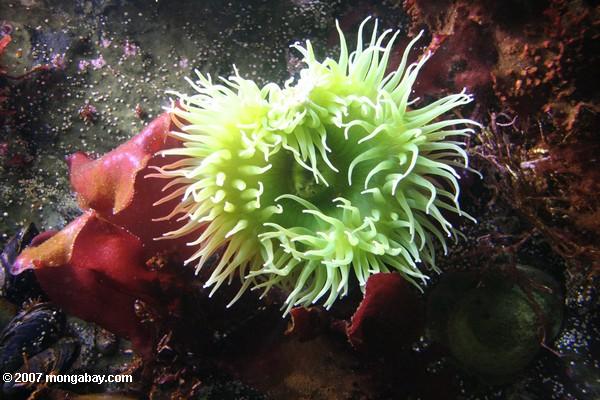A new report finds that the oceans are facing a mass extinction. One day many of the world’s marine species may only be found in aquariums, if at all, such as this green sea anemone in the Monterey Bay Aquarium. Photo by: Rhett A. Butler.
Multiple and converging human impacts on the world’s oceans are putting marine species at risk of a mass extinction not seen for millions of years, according to a panel of oceanic experts. The bleak assessment finds that the world’s oceans are in a significantly worse state than has been widely recognized, although past reports of this nature have hardly been uplifting. The panel, organized by the International Program on the State of the Ocean (IPSO), found that overfishing, pollution, and climate change are synergistically pummeling oceanic ecosystems in ways not seen during human history. Still, the scientists believe that there is time to turn things around if society recognizes the need to change.
“The findings are shocking,” Alex Rogers, IPSO’s scientific director and professor of conservation biology at Oxford University, said in a press release. “As we considered the cumulative effect of what humankind does to the oceans, the implications became far worse than we had individually realized. We’ve sat in one forum and spoken to each other about what we’re seeing, and we’ve ended up with a picture showing that almost right across the board we’re seeing changes that are happening faster than we’d thought, or in ways that we didn’t expect to see for hundreds of years.”
The Earth has seen five mass extinctions, and some scientists suggest we are seeing the signs of a sixth; although usually they point to the destruction of the world’s rainforests as proof, not the degradation of the oceans. However, the panel found that past mass extinctions of marine life included three signs: increased hypoxia or low oxygen levels, increasing ‘dead zones’, and ocean acidification. All three of these are occurring today due to human impacts in addition to overfishing and other issues.
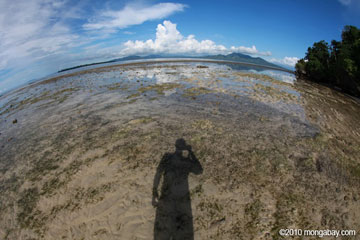 Low tide on the Indonesian island of Sulawesi. Photo by: Rhett A. Butler. |
Carbon dioxide, emitted by human activities, is entering the ocean at a rate not seen since the last marine mass extinction around 55 million years ago. Increased carbon sequestered in the oceans leads to acidification (lower pH levels), which is imperiling the world’s coral reefs, threatening algae species, and may doom iconic animals, like the clownfish. The full impacts of acidification are not yet known, but 55 million years ago half of marine species vanished.
In addition, climate change is melting Arctic sea ice and Greenland faster than anticipated, risking not only rising sea levels, but the possibility of methane release from underwater deposits.
Marine dead zones are also on the rise. In 2008 over 400 dead zones were identified globally, but recent research has found that such zones—where dissolved oxygen has fallen to such low levels that most marine species can no longer survive—are doubling every decades. Dead zones are caused by agricultural runoff, especially nitrogen-rich fertilizers, as well as the burning of fossil fuels.
Overfishing has already plundered the oceans of many key marine species. Some target fish and bycatch species (those killed unintentionally) have fallen by 90 percent report researchers. Following the collapse of target fish populations, industrial fisheries simply move onto other species until they too are decimated. Now, both the Arctic and the Antarctic are being eyed by industrial fisheries. The Arctic, which is becoming increasingly assailable due to melting sea ice from climate change, is also a recent target of oil and gas companies.
New research is also showing human trash in marine ecosystems to be more nefarious than expected. Tiny plastic particles are absorbing chemicals, such as flame retardants and synthetic musks, which are then then consumed by marine life. These chemicals have been found as far abroad as the polar seas. Other research has found that plastic decompose in the oceans much faster than expected, releasing potentially toxic substances.
All of these impacts, and others, are not allowing marine ecosystems time to recover, but instead are creating synergistic effects that are putting ocean ecosystems at grave risk.
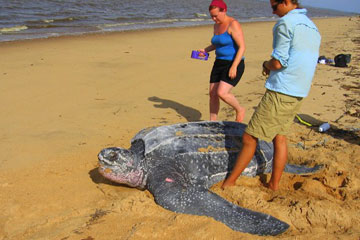 Scientist (right) works with volunteer to collect data on leatherback sea turtle nesting in Suriname. Leatherback sea turtles are listed as Critically Endangered by the IUCN Red List, in part due to drowning from bycatch. Photo by: Jeremy Hance. |
“The world’s leading experts on oceans are surprised by the rate and magnitude of changes we are seeing. The challenges for the future of the ocean are vast, but unlike previous generations, we know what now needs to happen. The time to protect the blue heart of our planet is now, today and urgent,” says Dan Laffoley, Marine Chair of IUCN’s World Commission on Protected Areas and report co-author said in a press release.
So, how do we prevent a marine mass extinction? Number one, according to the researchers, immediately reduce greenhouse gas emissions. They then recommend restructuring industrial fisheries for longterm sustainability, including shutting fisheries that are not sustainable; establishing more marine protected areas; tackling pollution and nutrient run-off; and reducing oil, gas, and mining in the oceans. The scientists say that the ‘precautionary principle’ must be used in terms of oceanic impacts, in other words society shouldn’t proceed with activities unless they are proven to be largely safe for marine ecosystems. Finally, researchers say the UN General Assembly must more effectively govern and regulate activities in the high seas, which are beyond any national jurisdiction.
According to the report, such large-scale changes are entirely possibly, but “current societal values prevent humankind from addressing them effectively.”
The report’s full findings will be released at the UN in New York later in the week.
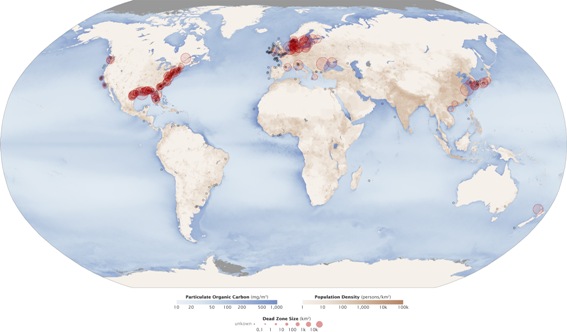
Created by satellite, the red circles on this map show the location and size of many of our planet’s dead zones. Black dots show where dead zones have been observed, but their size is unknown. Darker blues in this image show higher concentrations of particulate organic matter, an indication of the overly fertile waters that can culminate in dead zones. Image courtesy of NASA. Click on image to enlarge.
Related articles
Longline fishing still drowning over a quarter million seabirds every year
(06/08/2011) A new analysis estimates that longline fisheries are still decimating seabirds, even after years of efforts to mitigate deaths. According to a study in Endangered Species Research around 300,000 seabirds are drowned by longline fisheries as bycatch. Attracted by bait on the longline—sometimes measuring hundreds of miles as it trails on the surface behind a boat—birds are often hooked and drowned.
Noise in oceans leads to ‘severe acoustic trauma’ in octopus, squid
(04/12/2011) Researchers have documented for years how noise pollution impacts dolphins in whales, but a new study in Frontiers in Ecology and the Environment finds that even low intensity noise can severely injure cephalopods, which include octopus, squid, and cuttlefish. The injuries are bad enough to possibly lead to stranding and death, thereby providing a feasible explanation for a number of recent strandings, including giant squid washing ashore in Spain.
Antarctic penguins losing to climate change through 80% krill decline
(04/11/2011) Climate change has hit species of Antarctic penguins by causing a staggering decline in their prey: krill. A new study in the Proceedings of the National Academy of Sciences (PNAS) has found that both chinstrap penguins (Pygoscelis antarcticus) and Adélie penguins (Pygoscelis adeliae) have seen their populations decline likely do to less krill, instead of habitat changes. Since 1970 krill populations have fallen by 80% in the Southern Ocean surrounding Antarctica. Because krill require sea ice to reproduce, shrinking sea ice from climate change has made it more difficult for them to breed.
Coral crisis: 75% of the world’s coral reefs in danger
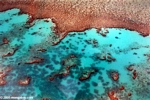
(02/23/2011) Marine scientists have been warning for years that coral reefs, the most biodiverse ecosystems in the ocean, are facing grave peril. But a new comprehensive analysis by the World Resources Institute (WRI) along with twenty-five partners ups the ante, finding that 75% of the world’s coral reefs are threatened by local and global impacts, including climate change. An updating of a 1996 report, the new analysis found that threats had increased on 30% of the world’s reefs. Clearly conservation efforts during the past decade have failed to save reefs on a large-scale.
Arctic fish catch vastly underreported (by hundreds of thousands of metric tons) for 5 decades
(02/07/2011) From 1950 to 2006 the United Nation Food and Agriculture Agency (FAO) estimated that 12,700 metric tons of fish were caught in the Arctic, giving the impression that the Arctic was a still-pristine ecosystem, remaining underexploited by the world’s fisheries. However, a recent study by the University of British Colombia Fisheries Center and Department of Earth and Ocean Sciences throws cold water on this widespread belief. According to the study, published in Polar Biology, the total Arctic catch from 1950 to 2006 is likely to have been nearly a million metric tons, almost 75 times the FAO’s official record.
The ocean crisis: hope in troubled waters, an interview with Carl Safina
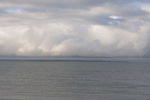
(02/07/2011) Being compared—by more than one reviewer—to Henry Thoreau and Rachel Carson would make any nature writer’s day. But add in effusive reviews that compare one to a jazz musician, Ernest Hemingway, and Charles Darwin, and you have a sense of the praise heaped on Carl Safina for his newest work, The View from Lazy Point: A Natural Year in an Unnatural World. Like Safina’s other books, The View from Lazy Point focuses on the beauty, poetry, and crisis of the world’s oceans and its hundreds-of-thousands of unique inhabitants. Taking the reader on a journey around the world—the Arctic, Antarctic, and the tropics—Safina always returns home to take in the view, and write about the wildlife of his home, i.e. Lazy Point, on Long Island. While Safina’s newest book addresses the many ways in which the ocean is being degraded, depleted, and ultimately imperiled as a living ecosystem (such as overfishing and climate change) it also tweezes out stories of hope by focusing on how single animals survive, and in turn how nature survives in an increasingly human world. However, what makes Safina’s work different than most nature writing is his ability to move seamlessly from contemporary practical problems to the age-old philosophical underpinnings that got us here. By doing so, he points a way forward.
Record high fish consumption keeps populations imperiled
(02/01/2011) More people than ever are eating more fish than ever, according to a new report by the United Nations covering the year 2008. At the same time, fish populations in the world’s oceans continue to decline threatening marine ecosystems, food security, and the fishing industry itself.
World has run out of fishing grounds
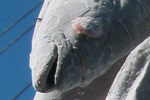
(12/06/2010) The world’s oceans can no longer accommodate fisheries expansion, confirms a study conducted by joint effort between the University of British Columbia and the National Geographic Society. The study is the first of its kind to analyze the geographic expansion of global fisheries. Published in the journal PLoS ONE, the study lends additional credence to reports that current fishing practices are unsustainable. Researchers holistically determined the ecological footprint of commercial fisheries by looking at primary production—the tiny organisms that make up the bottom of the food chain—and calculating the amount necessary to support current fishing yields around the world from 1950 to 2005. The study finds that the amount of primary production required to maintain commercial fishing at current levels far exceeds that which exists.
Beyond gloom: solutions to the global coral reef decline
(11/10/2010) The world’s coral reefs are in trouble. Due to a variety of factors—including ocean acidification, warming temperatures from climate change, overfishing, and pollution—coral cover has decline by approximately 125,000 square kilometers in the past 50 or so years. This has caused some marine biologists, like Charlie Veron, Former Chief Scientist of the Australian Institute of Marine Science, to predict that coral reefs will be largely extinguished within a century. This year alone, large-scale coral bleaching events, whereby coral lose their symbiotic protozoa and become prone to disease and mortality, were seen off the coasts of Indonesia, the Philippines, and some Caribbean islands. However a new paper in Trends in Ecology and Evolution attempts to dispel the gloom over coral reefs by pointing to strategies, and even some successes, to save them.
Carbon emissions hurting coral recruitment
(11/08/2010) While research has shown that ocean acidification from rising CO2 levels in the ocean imperils the growth and survival mature coral reefs, a new study has found that it may also negatively impact burgeoning corals, by significantly lowering the success of coral recruitment. A study in the Proceedings of the National Academy of Sciences (PNAS) has found that coral recruitment could fall by 73% over the next century due to increasing acidification.
Colossal coral bleaching kills up to 95 percent of corals in the Philippines
(09/23/2010) It is one of the most worrisome observations: fast massive death of coral reefs. A severe wide-scale bleaching occurred in the Philippines leaving 95 percent of the corals dead. The bleaching happened as the result of the 2009-2010 El Niño, with the Indian Ocean and Southeast Asia waters experiencing significant thermal increase especially since the beginning of 2010.

(07/29/2010) “President Obama called it ‘the worst environmental disaster America has ever faced.’ So I thought I should face it and head to the Gulf”—these are the opening words on the popular blog Guilty Planet as the author, marine biologist Jennifer Jacquet, embarked on a ten day trip to Louisiana. As a scientist, Jacquet was, of course, interested in the impact of the some four million barrels of oil on the Gulf’s already depleted ecosystem, however she was as equally keen to see how Louisianans were coping with the fossil fuel-disaster that devastated their most vital natural resource just four years after Hurricane Katrina.
Backbone of marine food chain in alarming decline
(07/28/2010) Tiny marine algae, known as phytoplankton, are the backbone of the marine food chain, yet a new study in Nature has found that this backbone is disintegrating. Researchers discovered that since 1950 phytoplankton has declined by approximately 40 percent across the Northern Hemisphere, a decline that corresponds to warming waters due to climate change. Given that phytoplankton feed the oceans’ abundance all the way up the food chain—from zooplankton to fish to seabird to sharks to humans—the decline has likely impacted the very structure of the ocean.
In the midst of marine collapse will we save our last ocean?

(07/05/2010) Imagine an ocean untouched by oil spills: a sea free of pollution, invasive species, dead zones, and over-exploitation; waters where marine animals exist in natural abundance and play ecological roles undimmed by mankind. Such a place may sound impossible in today’s largely depleted oceans, but it exists: only discovered in 1841, the Ross Sea spreads over nearly a million kilometers adjacent to the Antarctic continent. Here killer whales, penguins, sea birds, whales, and giant fish all thrive. However, even with its status as the world’s ‘last ocean’, the Ross Sea has not escaped human impact. Over the last 15 years commercial fisheries have begun to catch one of its most important species in the ecosystem to serve them up on the dinner plates of the wealthy.
